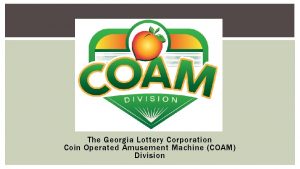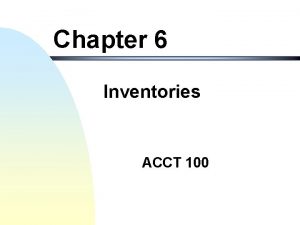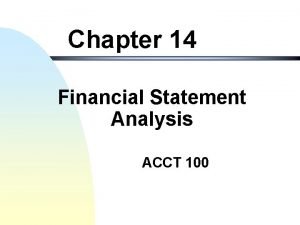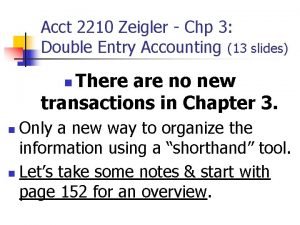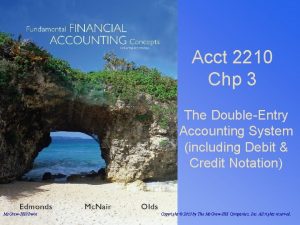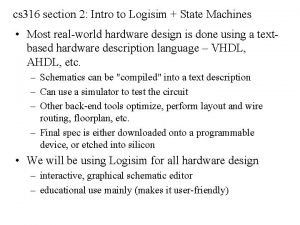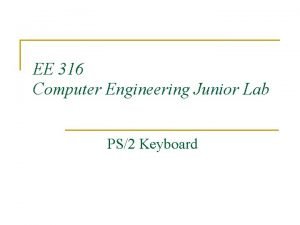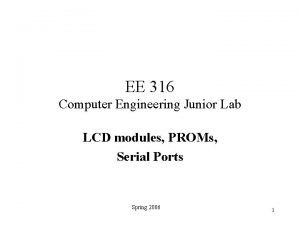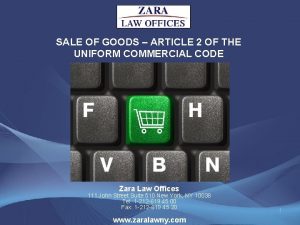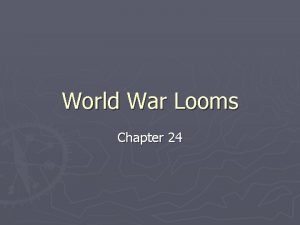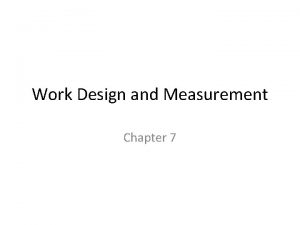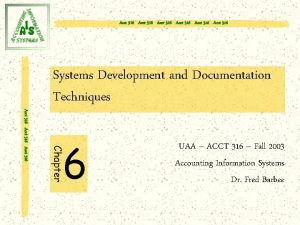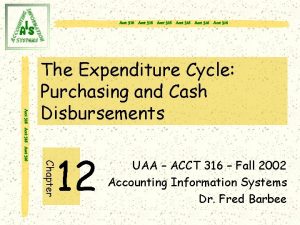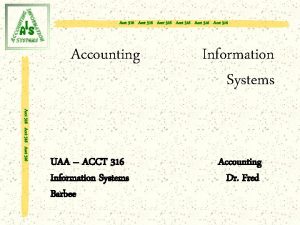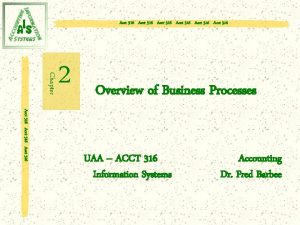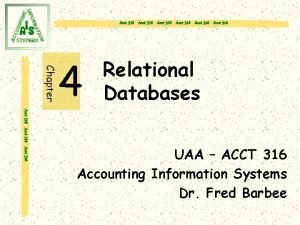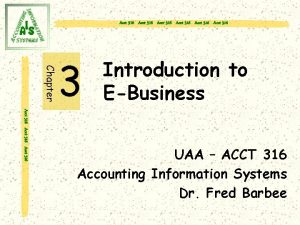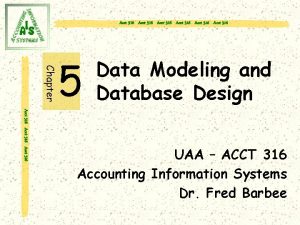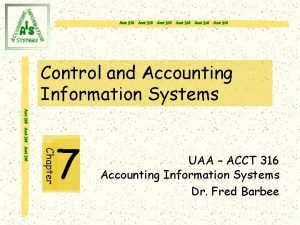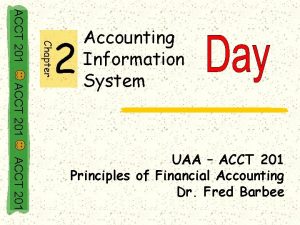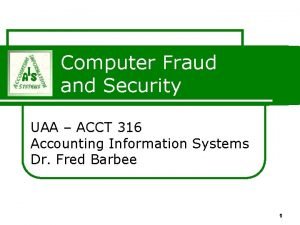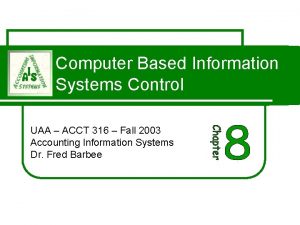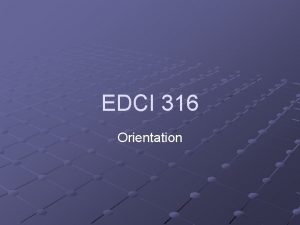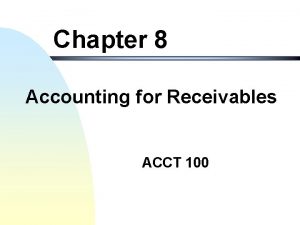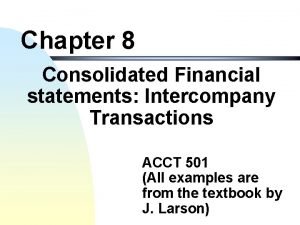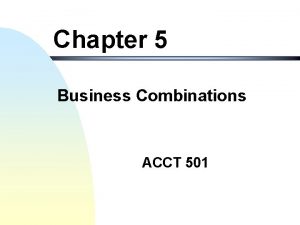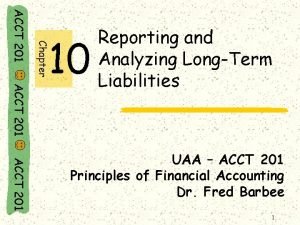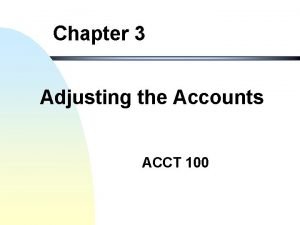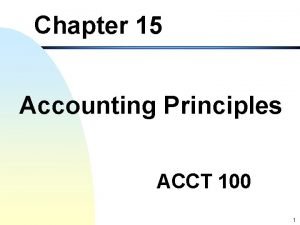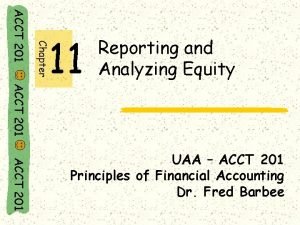Acct 316 Acct 316 12 Chapter Acct 316

























































- Slides: 57

Acct 316 Acct 316 12 Chapter Acct 316 The Expenditure Cycle: Purchasing and Cash Disbursements UAA – ACCT 316 – Fall 2002 Accounting Information Systems Dr. Fred Barbee


Acct 316 Acct 316 The Primary Objective Acct 316

Main Objective Acct 316 The primary objective of the expenditure cycle is to minimize the total cost of acquiring and maintaining inventories, supplies, and the various services necessary for the organization to function.

Acct 316 Acct 316 Acct 316 Key Decisions of the Cycle

Key Decisions What is the optimal level of inventory and supplies to carry? Acct 316 Which suppliers provide the best quality and service at the best prices?

Key Decisions Where should inventories and supplies be held? Acct 316 How can the organization consolidate purchases across units to obtain optimal prices?

Key Decisions Acct 316 How can information technology be used to improve both the efficiency and accuracy of the inbound logistics function?

Key Decisions Acct 316 Is sufficient cash available to take advantage of any discounts suppliers offer? How can payments to vendors be managed to maximize cash flow?

Acct 316 Acct 316 Acct 316 The Expenditure Cycle – Defined

Defined Acct 316 The expenditure cycle is a recurring set of business and related information processing operations associated with the purchase of and payment for goods and services.

Acct 316 Acct 316 Acct 316 The first function of a welldesigned AIS is to support the effective performance of the organization’s business activities.

Acct 316 Acct 316 Acct 316 The Expenditure Cycle – Business Activities


Business Activities 1. Order Goods Acct 316 2. Receive and Store Goods 3. Pay for Goods

Acct 316 Acct 316 Acct 316 Business Activities – Up Close and Personal

Acct 316 Acct 316 Acct 316 1. 0 Order Goods

Order Goods (Activity 1) Acct 316 The first major business activity in the expenditure cycle involves ordering inventory or supplies.

Order Goods (Activity 1) What to purchase? Acct 316 When to purchase? How much to purchase? From what supplier?

Order Goods (Activity 1) Inventory control methods: EOQ Acct 316 MRP JIT

Acct 316 Acct 316 Acct 316 What is the major difference between MRP and JIT?

MRP Systems Acct 316 Schedule production to meet estimated sales need, thereby creating a stock of finished goods inventory.

JIT Systems Acct 316 Schedule production to meet customer demands, thereby virtually eliminating finished goods inventory.

Acct 316 Acct 316 Acct 316 Documents and Procedures


Order Goods What is a key decision? determine vendor Acct 316 What factors should be considered? price quality of materials dependability in making deliveries


Acct 316 Acct 316 Acct 316 2. 0 Receive and Store Goods


Receive and Store Goods The receiving department has two major responsibilities: Acct 316 Deciding whether to accept a delivery Verifying quantity and quality


Acct 316 Acct 316 Acct 316 3. 0 Pay for Goods


Pay for Goods Acct 316 The objective of accounts payable is to authorize payment only for goods and services that were ordered and actually received.


Acct 316 Acct 316 Acct 316 Key Decisions and Information Needs

Acct 316 Acct 316 Acct 316 The third function of a welldesigned AIS is to provide useful information for decision making.

Key Decisions Determine when and how much additional inventory to order. Acct 316 Select the appropriate vendors from whom to order. Verify the accuracy of vendor invoices.

Key Decisions Decide whether purchase discounts should be taken. Acct 316 Monitor cash flow needs to pay outstanding obligations.

Other Information Needed Efficiency and effectiveness of the purchasing department Acct 316 Analyses of vendor performance such as on-time delivery, quality, etc.

Other Information Needed Time taken to move goods from the receiving dock into production Acct 316 Percentage of purchase discounts taken

Acct 316 Acct 316 Acct 316 Control Objectives, Threats, and Procedures

Acct 316 Acct 316 Acct 316 The second function of a well -designed AIS is to provide adequate controls to ensure the firm meets its objectives.

Control Objectives Transactions are properly authorized. Acct 316 Recorded transactions are valid. Valid, authorized transactions are recorded. Transactions are recorded accurately.

Control Objectives Assets (cash, inventory, and data) are safeguarded from loss or theft. Acct 316 Business activities are performed efficiently and effectively.

Acct 316 Acct 316 Acct 316 Threats to the Expenditure Cycle

Threats Stockouts Acct 316 Purchasing too many or unnecessary goods Purchasing goods at inflated prices Purchasing goods of inferior quality

Threats Purchasing from unauthorized vendors Acct 316 Kickbacks Receiving unordered goods Errors in counting goods

Threats Theft of inventory Acct 316 Failure to take available purchasing discounts Errors in recording and posting purchases and payments Loss of data

Acct 316 Acct 316 Acct 316 Expenditure Cycle Exposures

Exposures Production delays and lost sales Increased inventory costs Acct 316 Cost overruns Inferior quality of purchased goods Inflated prices

Exposures Violation of laws or import quotas Acct 316 Payment for items not received Inaccurate inventory records loss of assets

Exposures Cash flow problems Acct 316 Overstated expenses Incorrect data for decision making

Acct 316 Acct 316 Acct 316 Expenditure Cycle Control Procedures

Control Procedures Inventory control system Acct 316 Vendor performance analysis Approved purchase requisitions Restricted access to blank purchase requisitions

Control Procedures Price list consultation Acct 316 Budgetary controls Use of approved vendor lists Approval of purchase orders Prenumbered purchase orders

Control Procedures Prohibition of gifts from vendors Acct 316 Incentives to count all deliveries Physical access control Recheck of invoice accuracy Cancellation of voucher package
 Georgia lottery vending machines
Georgia lottery vending machines Acct 100
Acct 100 Acct 100
Acct 100 Where is preferred dividends on financial statements
Where is preferred dividends on financial statements Acct challenge course
Acct challenge course Acct 2210
Acct 2210 Acct 2210
Acct 2210 316 stainless steel tables
316 stainless steel tables Cos 316 princeton
Cos 316 princeton Cs 316
Cs 316 316 loài vẹt
316 loài vẹt Ee 316
Ee 316 Ee 316
Ee 316 Ucc 2-703
Ucc 2-703 Summary of the red tent
Summary of the red tent The great gatsby summary
The great gatsby summary Chapter 10 chemical reactions
Chapter 10 chemical reactions Chapter 11 stoichiometry assessment answer key
Chapter 11 stoichiometry assessment answer key Chapter 9 chapter assessment chemical reactions
Chapter 9 chapter assessment chemical reactions Chapter 7 similarity
Chapter 7 similarity Chapter 6 career readiness review
Chapter 6 career readiness review Chapter 7 ionic and metallic bonding chapter answer key
Chapter 7 ionic and metallic bonding chapter answer key Chapter 9 surface water chapter assessment answer key
Chapter 9 surface water chapter assessment answer key Chapter 2 representing motion assessment answers
Chapter 2 representing motion assessment answers The central science 14th edition
The central science 14th edition Chapter 7 ionic and metallic bonding chapter answer key
Chapter 7 ionic and metallic bonding chapter answer key Chapter 4 population ecology test answer key
Chapter 4 population ecology test answer key Chapter 2 chapter assessment
Chapter 2 chapter assessment Facts about the philippian jailer
Facts about the philippian jailer Ionic compound properties
Ionic compound properties Chapter 7 chapter assessment ionic compounds and metals
Chapter 7 chapter assessment ionic compounds and metals Representative metal
Representative metal Zeta phi beta images graphics
Zeta phi beta images graphics Working with young children chapter 1
Working with young children chapter 1 Wuthering heights summary by chapters
Wuthering heights summary by chapters Chapter 6 wuthering heights
Chapter 6 wuthering heights Findings of qualitative research
Findings of qualitative research Gbyeg
Gbyeg Chapter 16 building vocabulary world war looms
Chapter 16 building vocabulary world war looms World war 1 and the russian revolution chapter 27
World war 1 and the russian revolution chapter 27 Chapter 27 lesson 4 world war 1 ends
Chapter 27 lesson 4 world war 1 ends Chapter 17 section 3 world history
Chapter 17 section 3 world history Chapter 32 assessment world history
Chapter 32 assessment world history Chapter 30 section 2 world history
Chapter 30 section 2 world history Chapter 8 nationalist revolutions sweep the west
Chapter 8 nationalist revolutions sweep the west What was the counter-reformation?
What was the counter-reformation? Chapter 10 section 2 central america and the caribbean
Chapter 10 section 2 central america and the caribbean Ap human geography chapter 11 vocab
Ap human geography chapter 11 vocab World geography chapter 3 climates of the earth answers
World geography chapter 3 climates of the earth answers Work measurement techniques
Work measurement techniques Chapter 14 section 1 work and power
Chapter 14 section 1 work and power Dado joint definition
Dado joint definition Chapter 9 adhesives gluing and clamping answer key
Chapter 9 adhesives gluing and clamping answer key Chapter 19 section 4 wilson fights for peace
Chapter 19 section 4 wilson fights for peace Financial markets and institutions chapter 1
Financial markets and institutions chapter 1 Why be happy when you could be normal themes
Why be happy when you could be normal themes Where the red fern grows chapter 10
Where the red fern grows chapter 10 Ap psychology chapter 14
Ap psychology chapter 14
